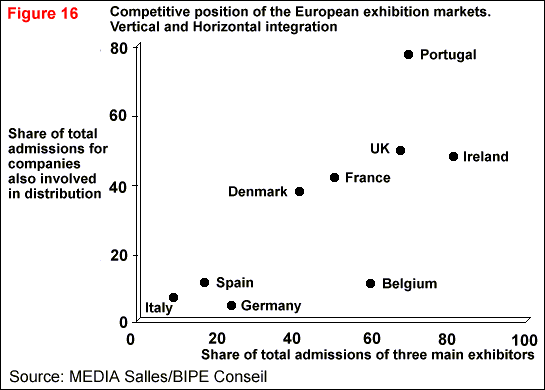2.3
Market failure (3)
The extent of competition in EU markets
The extent of competition in the market place is effected by both vertical
and horizontal restraints. The diagram below (Figure 16) plots the position
of countries in terms of two criteria: the market share of the different
circuits (horizontal integration) and the distributors' share of the exhibition
market. According to the diagram, the farther towards the top right-hand
corner a country is positioned in the graph, the more imperfect the competition.
Without taking account of agreements between distributors and exhibitors,
nor of eventual correction mechanisms, it appears a priori that
the problems of access of independent films to the cinemas and of independent
cinemas to films will probably be most acute in Portugal, Ireland and the
United Kingdom.

Competition within the theatrical sector
Obstacles to competition within the theatrical sector occur in two
dimensions, shown in the table below (4).
|
Barriers to access
|
Films with significant commercial potential
|
Other films
|
| Cinema programmed
by a circuit
|
- -
|
|
| Independent,
self-programmed cinema |
+ +
|
- -
|
| ++ strong;
-- weak |
Access by independent exhibitors to films
We have already shown that the problem of restricted access by independents
to films because of exclusivity is mainly confined to a limited number
of local markets: elsewhere the circuits have gained a monopoly position,
or the position of the small cinemas has been improved in some way by additional
print subsidy mechanisms. In a sense it is rather late to address the access
issue in the European Union where nearly 20% of all screens are now owned
by circuits and about another 40% are programmed by them.
However, for the remaining 40%, the problems of access to copies are
different depending on the market served:
-
In a competitive area (a large urban area, or the capital), the problems
of access to copies are a function of the advantages which a cinema owned
by or affiliated to a circuit naturally has: it tends to be better located,
better equipped etc. For the US-based distributors, who usually release
a film simultaneously to a large number of cinemas, the circuits can respond
better than the independents to their needs, as release to the latter would
require numerous separate negotiations.
-
In a less profitable local market, typically in small and medium-sized
towns, the exhibitor may well encounter problems of access to a copy upon
release which come simply from the limited number of copies available,
as the more profitable exhibitors are given priority. This problem can
be resolved by a policy of subsidising copies. Physical access to the film
arising from the problem of limited releases of copies is the problem most
often cited by independent exhibitors.
· Access by non-"blockbuster" films to
the cinemas
As will be seen in greater detail in the section analysing programming,
the techniques of "intensive" exhibition commonly practised by the circuits
throughout the EU make difficult the access to the big complexes and circuits
by independent films with less commercial potential. Only a few copies
are made available, their distributors do not commit the level of advertising
investment of the US majors or the subsidiaries of vertically-integrated
companies, so these films very rarely achieve the "cross-over" to being
shown in the more important cinemas. When they do arrive, they are only
played in the big urban complexes for a very short time, as the complexes
prefer to maximise the return on their screens by showing the high profile
films for a short period, rather than waiting for word of mouth to spread
the fame of an auteur film.
A strategy which guarantees the existence of an "independent" channel
of programming in the face of the integrated circuits, and which provides
a channel that gives films other than "block-busters" privileged entry
into the exhibition sector, will have first to resolve the problems facing
films with only limited audience appeal. It will be made even more difficult
by the fact that exhibitors, whatever their standing and their degree of
independence, still need "block-busters" to establish their business in
such a way that they can give screen time to "independent" films and optimise
the returns from their cinemas. Which leads us into the problem of exhibitors'
access to films. Only cinemas which are dedicated to "specialist" films
escape this need to get hold of the top films as soon as they are released
nationally.
Conclusions
A picture emerges of a "two-speed" exhibition sector: on the one hand,
the cinemas organised into circuits, groups or programming agreements which
mainly show films on an exclusive basis, and on the other, the independent
cinemas, in a delicate position in relation to the distributors. This situation
is counterbalanced a little by the actions of exhibitors' associations
or public authorities in some countries (Germany, France); they protect
the exhibitors' position, and guarantee them fair access to films, as far
as they can.
The access of less profitable films to cinemas is limited by the arrival
of intensive release practices. There is a possibility that in the future
there will be a ghetto of independent cinemas in the competitive local
markets which leave space for alternative programming.
(3) These
issues are largely dealt with in section 2.2 on vertical integration strategies.
(4) In the majority
of countries, barriers to access take the following two forms:
* access
to films with significant commercial potential by self-programmed indipendent
cinemas
* access
to cinemas belonging to circuits of films with small commercial potential.





